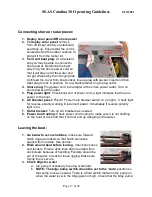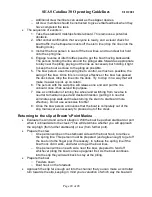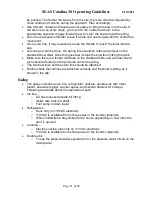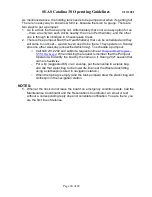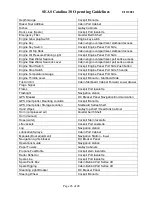
SEAS Catalina 30 Operating Guidelines
8/10/2021
Page 12 of 28
3.
Assign departure responsibilities to the crew.
4.
Assign one person as spotter in bow to look for other boat traffic and handle bow
lines. Bow person should remain at the ready with the anchor should an engine
failure or other emergency arise in the creek especially in the bridge area.
5.
Assign fender and line handlers on port and starboard sides to fend off boats in
adjacent slips and hang spring lines on pilings.
6.
On departure and entry keep a watchful eye on the depth gauge especially in the
Cheesequake creek and Keyport Harbor. There are shallow areas across from
Lockwood entrance, behind Railroad Bridge, and on both sides of Keyport
Harbor. Slow down and use extreme CAUTION if depth reading is 6 feet or less.
The Catalina 30 draws 5 ft 3 inches.
7.
Tune VHF radio to Channel 13 and listen for Bridge attendant instructions. Call
Bridge attendant to request passage to ensure the bridge will be opened.
8.
a. At Morgan: once past the bridge, go straight out past the first channel
marker lights, as there are rock jetties on both sides of the channel.
Stay in the channel, as the area immediately outside the bridge is
shallow.
b. At Matawan: once past Keyport #12 either follow the channel through
the mooring field or pass the mooring field to the west side
9.
Check to see if the engine is continuing to spit water out of the exhaust. Check
periodically while under engine power.
Getting Ready to Sail:
1.
When ready to sail, put mainsail up first and then unfurl the jib.
2.
Turn off engine by pulling up on the engine stop handle on the instrument panel.
This will cut off the fuel to the engine and stop it. After engine has stopped push
the stop handle down, turn off key switch and move transmission lever to reverse
position to keep the propeller from rotating. Never turn the key switch off while
the engine is running as it will damage the alternator.
3. Battery Switch:
With engine off switch battery switch to match day of month
(even day use #2 battery; odd day use #1 battery).
4.
The main sheet traveler is adjustable manually by releasing the traveler lines
from the cam cleats (one at each end of track) then position the car where
desired and pull the lines through the cam cleats to lock in place.
5.
Jib sheet blocks are adjusted by manually lifting the knurled knob on the block
and slide to a different position, then release the knob and ensure that it seats in
a hole in the track. The jib sheet blocks should be adjusted according to how
much jib is unfurled. There are labels next to the jib sheet track that correspond
to various amounts of jib exposed. For example, FULL, 75%, 50%, 25%. Look for
similar markings on the jib. Do not attempt to adjust the block position while there
is a load on the sheet. Best practice is to adjust the block for the lazy sheet then
adjust the block for the other sheet after the boat has changed tack. Alternatively,


















